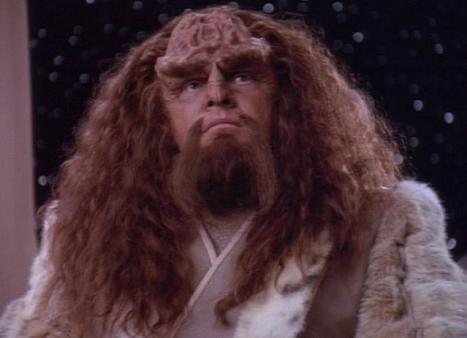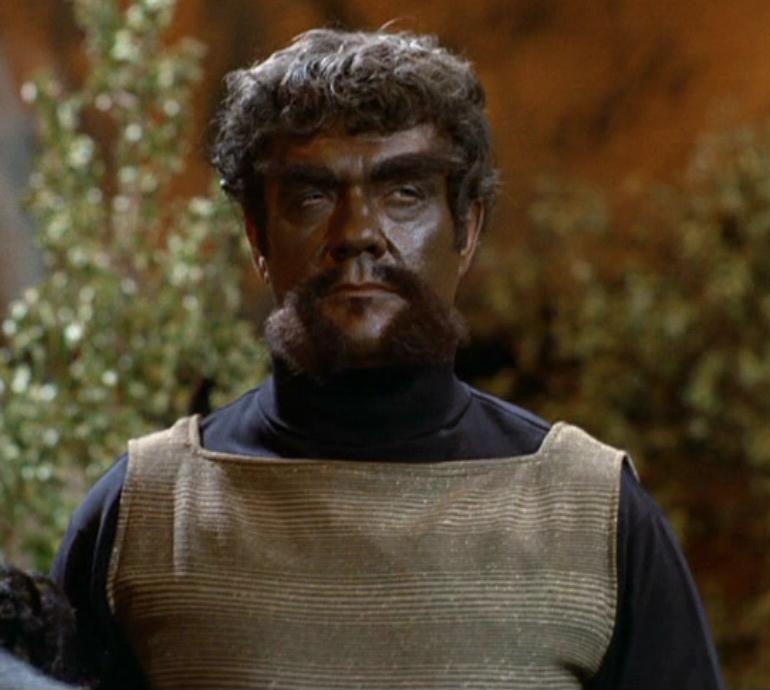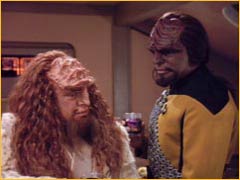
Worf, struggling with a crisis of faith, visits a Klingon monastery. While there, Kahless (Kevin Conway), the Klingon messiah introduced (sort of) back in TOS’s “The Savage Curtain”, appears. It’s a time of much rejoicing, but Klingon Chancellor Gowron (Robert O’Reilly) is skeptical and asks that the Enterprise transport Kahless and determine whether he’s the real deal. Genetic scans show he is — but he’s a little off. He doesn’t know what warnog tastes like and Gowron beats him fairly easily in a sword fight. It’s then revealed that this Kahless is a clone, cooked up by clerics at the monastery concerned that the empire has lost its way. Worf, initially despondent, has a talk about faith with Data, and then convinces Gowron to make the clone emperor and disclose his origins. Worf hopes this will unify the empire, but admits that his own faith is not healed.

Why it’s important
This episode explains Klingon mythology more than just about any other franchise product. Kahless is a Christ-like figure who established the warrior culture that we’ve seen throughout Star Trek. There are issues with that, as we’ll discuss.
But it’s interesting that this episode has less-than-expected results on the future of the Klingons. We never see Kahless again, and he’s only mentioned in passing a couple times (both on DS9, after Worf arrives). The idea was to use Kahless as a symbol with Gowron retaining the real power — and that’s definitely what happens. But given all the Klingon stuff on DS9, Kahless’s absence is noticeable. More telling is that his symbolic presence apparently does nothing to improve the Klingon situation. In DS9’s “Blood Oath” and in “The Way of the Warrior” the same complaints about the empire “losing its way” persist.

What doesn’t hold up
Well, Kahless here looks nothing like the evil dude/voice actor we saw in “The Savage Curtain”. The two characters don’t act like each other, either. I’ve heard the theory that Kahless in “The Savage Curtain” was some sort of version that those weird rock dudes created based on Kirk’s feelings toward Klingons (presumably, Kirk knew the name Kahless and extrapolated the rest — including the voice-mimicking skills). But that’s really expanded-universe nonsense. Basically, Klingons in TOS were bastards with beards who mostly looked human. Klingons in TNG (and beyond) could be treacherous, but were often honorable warriors with bumpy foreheads and long hair. The differences in the two Kahlesses can be chalked up to the differences in how the two series treated Klingons and made them look.
This episode sort of falls in line with the half-assed continuity seen with the Trill and Bajoran transitions from TNG to DS9. All three are well-intended attempts at callbacks that strain so far to fit new story constraints that one wonders if the strain was worth it. Was there really that much value in calling back aliens that appeared in one episode each — in this case, an episode nearly 25 years earlier — when doing so required that what we saw in the initial episode be tossed aside? If it didn’t matter that the aliens changed, why did it matter if they were brought back at all?
Keep in mind that in all three cases, other, similar aliens could have been created. Maybe the messiah in this episode could have been celebrated by another Klingon faith. Maybe the Bajorans could have been replaced by a different species subjugated by the Cardassians. Maybe the Trill would have been replaced by another, similar, joined species. None of that would have been too difficult, and none of it would have hurt the quality of the productions. Only the Bajorans, whose look mostly remained and who were represented after their initial introduction by Ensign Ro (Michelle Forbes) might have been significant enough to bring back even if it required rewriting a lot of backstory. But, then, why not just use the established backstory, or work harder to make all the pieces fit?
I guess my only other real gripe is that this episode — and the “Birthright” two-parter, in which Worf really opens up about Kahless for the first time — sort of retcon the idea of Klingon faith. Worf mentions Kahless to Alexander at one point (though he mispronounces the name) earlier in the series. But up until the sixth season of TNG, Worf isn’t shown to be a man of faith. Neither are any other Klingons.
Final thoughts
This is another episode — really, the last one in the series — that involves the Klingon mini-arc that began back in “Sins of the Father” or perhaps even “Heart of Glory”. Worf has a pretty big voice in Klingon politics and he essentially changes the course of an entire government and could have changed an entire culture, had Kahless’s presence affected more than it did. Of course, Worf’s role in Klingon culture comes back into play in DS9.
This episode suffers from being heavy-handed in spots, but I did like the scene with Data and Worf in the holodeck. It would have been very easy for Worf to get advice from Picard, Riker or even Troi. But picking Data was a nice touch that was handled with great precision. TNG had its flaws and lacked conflict among characters, but it probably knew its characters better than any other series (with DS9 a close second).
Coming later this week …
Data doesn’t get even. He gets mad.
